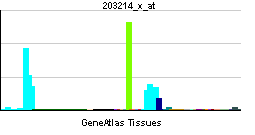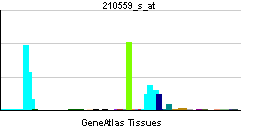Cdk1
| Cell division cycle 2, G1 to S and G2 to M | |||||||||||
|---|---|---|---|---|---|---|---|---|---|---|---|
| Identifiers | |||||||||||
| Symbols | CDC2 ; CDC28A; CDK1; DKFZp686L20222; MGC111195 | ||||||||||
| External IDs | Template:OMIM5 Template:MGI HomoloGene: 68203 | ||||||||||
| |||||||||||
| RNA expression pattern | |||||||||||
 | |||||||||||
 | |||||||||||
 | |||||||||||
| More reference expression data | |||||||||||
| Orthologs | |||||||||||
| Template:GNF Ortholog box | |||||||||||
| Species | Human | Mouse | |||||||||
| Entrez | n/a | n/a | |||||||||
| Ensembl | n/a | n/a | |||||||||
| UniProt | n/a | n/a | |||||||||
| RefSeq (mRNA) | n/a | n/a | |||||||||
| RefSeq (protein) | n/a | n/a | |||||||||
| Location (UCSC) | n/a | n/a | |||||||||
| PubMed search | n/a | n/a | |||||||||
Cell division cycle 2, G1 to S and G2 to M, also known as Cdk1 (CDC2), is a human gene. The protein encoded by this gene is called p34cdk1 and is a cyclin-dependent kinase in the Ser/Thr protein kinase family. This protein is a catalytic subunit of the highly conserved protein kinase complex known as maturation promoting factor (MPF), which is essential for G1/S and G2/M phase transitions of eukaryotic cell cycle. Mitotic cyclins stably associate with this protein and function as regulatory subunits. The kinase activity of this protein is controlled by cyclin accumulation and destruction through the cell cycle. The phosphorylation and dephosphorylation of this protein also play important regulatory roles in cell cycle control.[1]
Cdk1 is one of the components of the maturation promoting factor (MPF) which controls the cell division cycle in yeast. Cdk1 is a cyclin-dependent kinase (CDK) which, when bound to cyclin B, allows a dividing cell to enter into mitosis from G2 (in the absence of inhibitory proteins such as Wee1). Cdk1 also permits the transition from G1 through S in conjunction with cyclin A and cyclin E.[2]
In humans, the functions of cdc2 are divided between its homologues. Some important ones are Cdk1, Cdk2, Cdk4, and Cdk6 (See cyclin-dependent kinase), which associate with different cyclins and regulate stage transitions during the cell cycle.
Other "Cell division cycle" genes (cdc's) are also involved in complex regulatory pathways during the cell cycle. Cdc's were originally discovered in Saccharomyces cerevisiae, and are followed by a number which signifies the order in which they were discovered (e.g. cdc2, cdc20, cdc25, etc).
References
Further reading
- Draetta G, Eckstein J (1997). "Cdc25 protein phosphatases in cell proliferation". Biochim. Biophys. Acta. 1332 (2): M53–63. PMID 9141461.
- Kino T, Pavlakis GN (2004). "Partner molecules of accessory protein Vpr of the human immunodeficiency virus type 1". DNA Cell Biol. 23 (4): 193–205. doi:10.1089/104454904773819789. PMID 15142377.
- Kino T, Chrousos GP (2004). "Human immunodeficiency virus type-1 accessory protein Vpr: a causative agent of the AIDS-related insulin resistance/lipodystrophy syndrome?". Ann. N. Y. Acad. Sci. 1024: 153–67. doi:10.1196/annals.1321.013. PMID 15265780.
- Zhao LJ, Zhu H (2005). "Structure and function of HIV-1 auxiliary regulatory protein Vpr: novel clues to drug design". Curr. Drug Targets Immune Endocr. Metabol. Disord. 4 (4): 265–75. PMID 15578977.
- Le Rouzic E, Benichou S (2006). "The Vpr protein from HIV-1: distinct roles along the viral life cycle". Retrovirology. 2: 11. doi:10.1186/1742-4690-2-11. PMID 15725353.
- Zhao RY, Elder RT (2005). "Viral infections and cell cycle G2/M regulation". Cell Res. 15 (3): 143–9. doi:10.1038/sj.cr.7290279. PMID 15780175.
- Zhao RY, Bukrinsky M, Elder RT (2005). "HIV-1 viral protein R (Vpr) & host cellular responses". Indian J. Med. Res. 121 (4): 270–86. PMID 15817944.
- Kaldis P, Aleem E (2007). "Cell cycle sibling rivalry: Cdc2 vs. Cdk2". Cell Cycle. 4 (11): 1491–4. PMID 16258277.
- Li L, Li HS, Pauza CD; et al. (2006). "Roles of HIV-1 auxiliary proteins in viral pathogenesis and host-pathogen interactions". Cell Res. 15 (11–12): 923–34. doi:10.1038/sj.cr.7290370. PMID 16354571.
- Rietbrock N, Keller F (1977). "[Biologic availability and "1st pass" effect of drugs]". Fortschr. Med. 95 (28): 1765–6, 1774–80. PMID 914146.
- Azzi L, Meijer L, Reed SI; et al. (1992). "Interaction between the cell-cycle-control proteins p34cdc2 and p9CKShs2. Evidence for two cooperative binding domains in p9CKShs2". Eur. J. Biochem. 203 (3): 353–60. PMID 1310466.
- Dutta A, Stillman B (1992). "cdc2 family kinases phosphorylate a human cell DNA replication factor, RPA, and activate DNA replication". EMBO J. 11 (6): 2189–99. PMID 1318195.
- Koff A, Giordano A, Desai D; et al. (1992). "Formation and activation of a cyclin E-cdk2 complex during the G1 phase of the human cell cycle". Science. 257 (5077): 1689–94. PMID 1388288.
- Russo GL, Vandenberg MT, Yu IJ; et al. (1992). "Casein kinase II phosphorylates p34cdc2 kinase in G1 phase of the HeLa cell division cycle". J. Biol. Chem. 267 (28): 20317–25. PMID 1400350.
- Rubinfeld B, Crosier WJ, Albert I; et al. (1992). "Localization of the rap1GAP catalytic domain and sites of phosphorylation by mutational analysis". Mol. Cell. Biol. 12 (10): 4634–42. PMID 1406653.
- van der Sluijs P, Hull M, Huber LA; et al. (1992). "Reversible phosphorylation--dephosphorylation determines the localization of rab4 during the cell cycle". EMBO J. 11 (12): 4379–89. PMID 1425574.
- Seth A, Alvarez E, Gupta S, Davis RJ (1992). "A phosphorylation site located in the NH2-terminal domain of c-Myc increases transactivation of gene expression". J. Biol. Chem. 266 (35): 23521–4. PMID 1748630.
- Lees JA, Buchkovich KJ, Marshak DR; et al. (1992). "The retinoblastoma protein is phosphorylated on multiple sites by human cdc2". EMBO J. 10 (13): 4279–90. PMID 1756735.
- Nazarenko SA, Ostroverhova NV, Spurr NK (1991). "Regional assignment of the human cell cycle control gene CDC2 to chromosome 10q21 by in situ hybridization". Hum. Genet. 87 (5): 621–2. PMID 1916766.
- Nissen MS, Langan TA, Reeves R (1991). "Phosphorylation by cdc2 kinase modulates DNA binding activity of high mobility group I nonhistone chromatin protein". J. Biol. Chem. 266 (30): 19945–52. PMID 1939057.